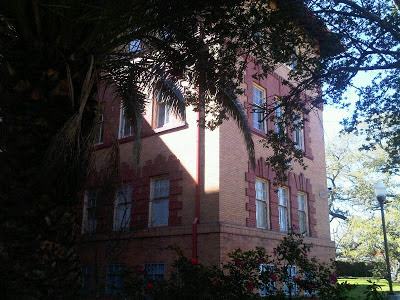In truth, the railroad was a dangerous a place to work in those days. From 1890 to 1917 alone, some two million workers were injured on the tracks, and 72,000 workers were killed. Another 158,000 were killed in incidents in the "roundhouses" and repair shops. You can read more here, but the author (a professor of history at UTSA) compares the 2.23 million deaths of railroad workers in this short period to the total deaths suffered by the United States in its wars from the Revolutionary to Persian Gulf, 2.42 million.
He describes one incident in San Antonio in particular, in 1911, when a boiler on a steam engine failed, spewing the massive locomotive's engine--all of it--in chunks and splinters explosively through the sky. Body parts and metal crashed through roofs of nearby homes and rail shops, killing and maiming the unsuspecting by-standers. Metal rained from the sky blocks away. The shock reverberated like an earthquake felt even miles away. And the gruesome task of recovering bits of bodies and searching for the wounded began.
"Where Seventeen Railroads Met the Sea," Houston was the largest railroad center in the southern United States. Southern Pacific was the second transcontinental railway in the US, as of 1881 with its Sunset Route, but its oldest line started right here in Houston in 1851: the Buffalo Bayou, Brazos & Colorado Railway.
Southern Pacific built not just this hospital but, in 1911, also a ten-story, Art Deco downtown office building now used as the Bayou Lofts.
In 1913, Houston was a spectacular confluence of industry near the Gulf of Mexico. We were bustling and energetic. The Houston Ship Channel was being deepened to 27 feet to accommodate the largest ocean-going ships, and its deepening was targeted for the opening of the Panama Canal in 1914. Wharves, with free use promised, were expanding. Oil (no surprise, huh?), lumber, sugar, timber, rice, fruit, and (above all) cotton from Texas and Oklahoma were ready for export. With 33 "tall buildings" of six stories and higher, we even had "skyscrapers" from ten to eighteen stories high--including the aforementioned regional office of the Southern Pacific. Our burgeoning population topped 125,000. Fed by newcomers, just like today, Houston has long been a city that takes all in stride.
 |
| Early 1900s' cotton bales at Houston's Grand Central Station. Near the present Amtrack station. |
Alas, 1917 was the peak year for rail trackage in the United States. In December of that year, the federal government took temporary control of railways in preparation for World War I. The tracks were used heavily in the war effort, but weren't maintained well by the government. The Great Depression followed, cutting rail revenue in half. Although rail use returned through World War II, the golden era of trains had passed. Through the 1950s and 1960s, the interstate highway system, commercial aviation, pipelines, and commercial bus service took its toll. In 1984, Southern Pacific merged into the Santa Fe, but was re-sold a few years later when the federal government did not approve the merger.
In 1988, the hospital property was sold to the University of Texas. It was used shortly for MD Anderson patients recovering from cancer. In 1989 it became the Houston Hospital District's free-standing Thomas Street Clinic for HIV/AIDS. Finally, it's said to be haunted. Go take a look!





No comments:
Post a Comment